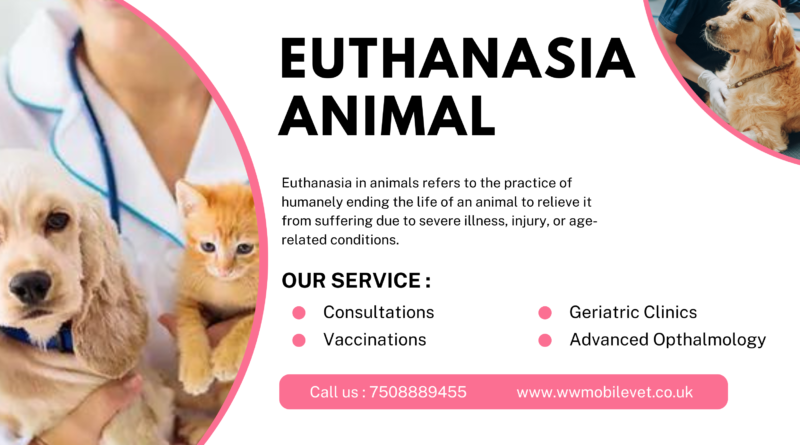Understanding Euthanasia Animals: An Guide for Pet Guardians
Euthanasia, often referred to as “putting an animal to sleep,” is one of the most challenging decisions pet guardians ever have to make. The word “euthanasia” comes from the Greek words “eu,” meaning good, and “thanatos,” meaning death. Euthanasia animals means providing a humane and compassionate end to an animal’s suffering. This process is not only an act of kindness but also a testament to the love and responsibility we hold for our animal companions. In this guide, we will explore the various aspects of euthanasia animals, helping pet guardians understand the process, considerations, and emotional journey involved.
What is Animal Euthanasia?
Animal euthanasia is a medical procedure that allows pets to pass away peacefully and without pain. This procedure is typically performed by a veterinarian and involves administering an overdose of anesthetic drugs. The process is quick, painless, and designed to ensure that the animal does not suffer.
When to Consider Euthanasia?
Deciding when to euthanize an animal is incredibly personal and often heart-wrenching. Several factors should be considered to make an informed decision:
- Quality of Life: One of the primary considerations is the animal’s quality of life. Indicators of poor quality of life include chronic pain, inability to eat or drink, difficulty breathing, and loss of interest in activities they once enjoyed.
- Veterinarian’s Advice: Veterinarians can provide invaluable guidance. They can assess the animal’s health and provide a professional opinion on whether euthanasia is the most humane option.
- Chronic Illness or Injury: In cases where an animal is suffering from a chronic illness or injury that significantly impairs their quality of life and has no chance of recovery, euthanasia might be the kindest choice.
- Personal Beliefs and Wishes: Each pet guardian has personal beliefs and wishes regarding their pet’s end-of-life care. It’s essential to consider what feels right for you and your beloved pet.
The Euthanasia Process
Understanding what to expect during the euthanasia process can help ease some of the anxiety associated with it. Here’s a step-by-step guide:
- Preparation: Discuss the procedure with your veterinarian. They can explain what will happen and answer any questions you might have. Some pet guardians prefer to have the procedure done at home for a more comfortable and familiar setting for the pet.
- Sedation: In many cases, the veterinarian will first administer a sedative to help relax the animal and minimize any discomfort or anxiety.
- Euthanasia Injection: The euthanasia solution is typically administered via an intravenous injection. The drug used is an overdose of an anesthetic agent, causing the animal to lose consciousness and pass away peacefully within a few minutes.
- Post-Procedure: After the procedure, you may spend some time with your pet to say goodbye. The veterinarian can also discuss options for aftercare, such as cremation or burial.
Emotional Impact on Pet Guardians
The emotional impact of euthanasia on pet guardians can be profound. It’s important to acknowledge and address these feelings:
- Grief and Loss: Losing a pet is akin to losing a family member. It’s natural to experience a range of emotions, including sadness, guilt, and even relief that the pet is no longer suffering.
- Support Systems: Seek support from friends, family, or pet loss support groups. Sharing your feelings with others who understand can be incredibly healing.
- Memorializing Your Pet: Creating a memorial for your pet can be a meaningful way to honor their memory. This could include planting a tree, creating a scrapbook, or holding a small ceremony.
Making the Decision
Making the decision to euthanize an animal is deeply personal and unique to each situation. Here are some tips to help you through this difficult time:
- Gather Information: Educate yourself about your pet’s condition and prognosis. Understanding the medical facts can help you make an informed decision.
- Consider Your Pet’s Wishes: Think about what your pet’s quality of life might be and what they would want if they could communicate their wishes.
- Talk to Your Veterinarian: Open, honest communication with your veterinarian can provide clarity and support.
- Trust Yourself: Trust that you know your pet better than anyone else. Your decision will come from a place of love and compassion.
Promoting a Compassionate Approach
Euthanasia, while challenging, is often the most compassionate choice for animals suffering from severe, untreatable conditions. It is an act of love and responsibility, ensuring that our beloved pets do not endure unnecessary pain or distress.
Finding the Right Veterinarian
Choosing the right veterinarian to perform the euthanasia is crucial. You want someone who is not only skilled but also compassionate and understanding.
For those located in the UK, Wilmington Veterinary Clinic offers mobile veterinary services, providing a convenient and comfortable option for pet guardians. Their experienced team understands the emotional difficulty of this decision and strives to provide the most humane and compassionate care possible.
Conclusion
Euthanasia animals is a topic that evokes deep emotions, but it is an essential part of responsible pet guardianship. Understanding the process, considering the quality of life, and making an informed decision can help ensure that your beloved pet’s final moments are peaceful and dignified. Remember, this decision comes from a place of love and the desire to prevent suffering.
If you are facing this difficult decision, know that you are not alone. Resources and support systems are available to help you through this challenging time. Visit Wilmington Veterinary Clinic for compassionate and professional veterinary care, and ensure that your pet’s final journey is as peaceful as possible.


